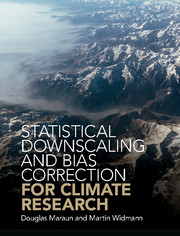Book contents
- Frontmatter
- Dedication
- Contents
- Preface
- Acknowledgements
- 1 Introduction
- Part I Background and Fundamentals
- 2 Regional Climate
- 3 History of Downscaling
- 4 Rationale of Downscaling
- 5 User Needs
- 6 Mathematical and Statistical Methods
- 7 Reference Observations
- 8 Climate Modelling
- 9 Uncertainties
- Part II Statistical Downscaling Concepts and Methods
- Part III Downscaling in Practice and Outlook
- Appendix A Methods Used in This Book
- Appendix B Useful Resources
- References
- Index
7 - Reference Observations
from Part I - Background and Fundamentals
Published online by Cambridge University Press: 27 December 2017
- Frontmatter
- Dedication
- Contents
- Preface
- Acknowledgements
- 1 Introduction
- Part I Background and Fundamentals
- 2 Regional Climate
- 3 History of Downscaling
- 4 Rationale of Downscaling
- 5 User Needs
- 6 Mathematical and Statistical Methods
- 7 Reference Observations
- 8 Climate Modelling
- 9 Uncertainties
- Part II Statistical Downscaling Concepts and Methods
- Part III Downscaling in Practice and Outlook
- Appendix A Methods Used in This Book
- Appendix B Useful Resources
- References
- Index
Summary
Observations are key to any modelling application; they tie the model to reality. In statistical downscaling, observations are needed for both calibration and evaluation. They are either needed as predictor or predictand data.
In the Global Climate Observation System (GCOS) report to the United Nations Framework Convention on Climate Change (UNFCCC) at the fourth conference of the parties (COP-4; GCOS 1998) it is stated that in practice, available observations often have major deficiencies with respect to climate needs. While considerable progress has been made since then (e.g. Karl et al. 2010), fundamental limitations persist. Observational data, both gridded and station data, should not naively be considered true. All observations are a measurement of a physical quantity, often followed by some postprocessing. As such they are based on some type of model. This is obvious for gridded observations or reanalyses, which are derived via some interpolation or numerical weather prediction model. But also station measurements are based on some technical device (a thermometer inside a shelter, a bucket), which is assumed to correctly represent a meteorological variable (air temperature, precipitation). Therefore, observations are subject to often substantial random and systematic errors. For any useful application of observational data in a given context, it has to be known how it has been generated in order to understand what this data actually represents and what its limitations are.
Predictand Data
Statistical downscaling is often desired to downscale to station data (in particular in PP). There is, however, a growing demand to provide full fields and gridded products.
Station Data
Historical climate observations, in particular before the 1970s, are typically based on station-based measurements. These have in turn been used to calibrate locally operating impact models. To generate projections of the impacts of climate change, impact modellers therefore often demand downscaling to these station locations. Most PP methods in fact attempt to provide such results.
In many regions such as Europe and North America, a dense network of weather stations exists, especially of rain gauges (Figure 7.1). In some regions, however, stations are not regularly shared, are sparse or even no station data exists.
Information
- Type
- Chapter
- Information
- Publisher: Cambridge University PressPrint publication year: 2018
